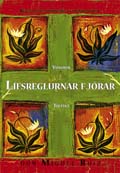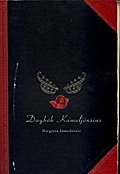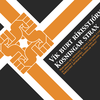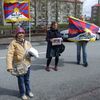30.3.2008 | 09:16
Tíbetar eru sem fuglar í neti í landi sínu
Óhugnalegar staðreyndir um það sem Tíbetar þurfa að þola í sínu daglega lífi
Ég fann eftirfarandi grein á vef the Independent áðan. Hún byggist á viðtali við Tash sem fór til Tíbet til að gera heimildarmynd um hvað er í raun og veru að gerast í ættlandi hans. En hann flúði Tíbet þegar hann var 18 ára gamall. Um 3000 manneskjur flýja Tíbet ár hvert yfir hina háu fjallagarða. En það eru ekki náttúröflin sem eru þeim hættumest, heldur leyniskyttur úr landamæralögreglunni sem skjóta þau á færi og skilja svo líkin eftir á víðavangi. Þeirra eini glæpur: að vilja yfirgefa Tíbet. Ég hvet ykkur til að lesa þessa grein og ef þið hafið aðgang að Channel 4 að horfa á heimildarmyndina hans á morgunn.
"My Tibet: Secret report from the roof of the world
Eleven years ago, Tash, above, risked his life to flee Tibet. Now he has risked it again, by returning with a hidden camera to film the stories of torture, murder and forced sterilisation that China does not want the world to hear.
By Clare Dwyer Hogg
Sunday, 30 March 2008
Tash does not look like a man who has just put his life in danger. But as he sits in a cosy editing suite in London, the images on the screens around him – a Tibetan political prisoner showing his scars, a still of Tash interviewing a Buddhist monk – prove the contrary. He has risked his life at least twice: the first time, 11 years ago, to escape his native Tibet; and then, as the screens document, when he went back with a hidden camera to expose what he felt were injustices perpetrated by the Chinese government. "I can now never go back to Tibet," he says. "But it is worth it."
What makes his actions particularly dangerous is the Chinese government's blanket ban on journalists entering Tibet. His report for Channel 4's Dispatches reveals detail not seen before: reports last month of the recent uprisings could only be given by major news sources from vantage points outside the country – usually Nepal – conveying what snatches of second-hand experiences they could garner from the other side of the Himalayas. Tibet has an estimated one Chinese soldier for every 20 Tibetans – as opposed to one soldier per 1,400 Chinese citizens. This country, about the size of western Europe, has been firmly in the grip of the Chinese government since the Dalai Lama fled in 1959.
Tash fled Tibet, too, when he was 18, without telling his family. Yet as a boy he had been protected from knowing too much of the political repression. "I knew there were some people who had the Dalai Lama's book My Land and My People," he says, "but when I saw them talking they wouldn't let me join in – I was too young."
He says everybody practised in secret. "Boys would secretly watch the films of the Dalai Lama teachings, but no one knew anything of the outside world." Eager to escape to that unknown, Tash travelled the treacherous journey across the mountains to India, past frozen bodies half buried in the snow, to freedom.
Not everyone is so fortunate. Footage captured by Western climbers in September 2006 (and shown in the Dispatches programme) has a line of refugees plodding through the snow, with some of their number suddenly picked off by bullets fired by the Chinese soldiers behind them. "They shot a girl dead right in front of me and dumped her corpse in a hole nearby," one of the group remembers.
These people were deliberately escaping from what they considered Chinese tyrannies. As a young refugee looking for an education in India, though, Tash didn't realise the insulated nature of his old life until the political relevance of his new-found freedom began to hit home. "On Tibetan television almost every night, there would be stories about the Japanese invading China, committing genocide, beheading the Chinese and raping girls. I used to hate Japanese people, until I came into India and realised that it was propaganda," he recalls. The memory of a life in Tibet without fear seemed even more preposterous during his three-month undercover operation there last summer.
"When we were in Tibet I was greatly shocked," he says, clenching his hand into a gentle fist. "We're going to lose all Tibetan identity soon. In Lhasa, if you don't speak Chinese, it doesn't matter how good your Tibetan or English is, you don't get a job." And the fading of the ethnic way of life, he was distraught to find, is down to more than this systematic wearing away of cultural and religious ties. Through tip-offs and a web of contacts, he discovered that Tibetan women are being forcibly sterilised.
One woman agreed to speak to Tash, despite the cultural propriety that would rarely see a woman speak about such intimacies with a man, and the obvious dangers of criticising the government. "I was taken away against my will," she explains. She has two children – more than the "one child" policy allows – and could not afford to buy a certificate that stated she had been sterilised. "Apparently they cut the fallopian tubes and stitch them up," she says ruefully. "When they opened me up they pulled them out by the roots. It was agonisingly painful." They didn't use anaesthetic, or provide any drugs aside from aspirin. "I was sick and giddy," she says. "From the day after the operation I had to look after myself. If I needed a drip I had to pay for it myself."
Anyone who speaks out against the policies of the Chinese government like this, or calls for the freedom of Tibet, is in danger of being condemned a "splittist" – someone who is splitting from the Communist Party – and sent to prison. This, Tash discovered, can be for as little as raising a Tibetan flag in a meeting. A farmer, found guilty of this crime, explains: "I spent the prime of my life in prison ... from the age of 24 to 37." And so, the culture of fear is continually reinforced by harsh sentences for apparently minor crimes. An 18-year-old Buddhist monk, Tash says, was recently sent to prison for three years for inscribing "Free Tibet" in a book.
And time spent in a Chinese prison invariably means torture. One ex-political prisoner on Tash's film explains the use of handcuffs: "There are types that bind the two thumbs together," he says, demonstrating. "And others are serrated so they cut into the flesh of the wrists. They handcuff you and hang you from the ceiling then beat you. They strike your body with iron bars."
A Human Rights Watch report in 2007 claimed that tens of thousands of Tibetans have been moved into permanent camps. Tash visited a cluster of little concrete homes, miles away from any town: the people he spoke to expressed unhappiness, but with their livestock confiscated and roaming on the grasslands forbidden, they have no hope of changing things. Apart from protest, of course, but openly protesting against the police is widely acknowledged as a way to bring your life to a swift and bloody end.
Only after spending time in his homeland with the perspective of freedom does Tash understand an incident in his youth that he, blissfully ignorant, could not comprehend at the time. "When I was about 16 I sang an old song about the Dalai Lama at my village's New Year festival," he says. A friend had given him the words, and he didn't know it was banned. "When I sung, the old men and women were crying, I didn't know why. The head of the village thanked me and put a red scarf round my neck." Now he sees the situation all too clearly. "Tibetans," he says, "are trapped. They are like birds in a net."
'Dispatches: Undercover in Tibet' is on Channel 4 tomorrow at 8pm
Interesting? Click here to explore further"

|
Mótmæli í Tíbet |
| Tilkynna um óviðeigandi tengingu við frétt | |
Flokkur: Stjórnmál og samfélag | Facebook
Tenglar
Nýja Ísland
Ég les:
Tíbet
- Fréttir frá Tibet
- Tibet Info Net An Independent Information Service on Contemporary Tibet
- Undercover in Tibet Ný heimildarmynd frá Channel 4 um hvernig ástandið er í raun og veru í Tíbet
- Leaving Fear Behind Viðtöl við Tíbeta í Tíbet stuttu fyrir mótmælin í mars
- Cry of the Snow Lion Margverðlaunuð heimildarmynd um Tíbet
- Yeti - heimildarmynd
- Yogis of Tibet Heimildarmynd um Jógameistara Tíbets sem eru óðum að hverfa
- Students for a Free Tibet
- Dalai Lama
- Tibetan Uprising
- Kerti fyrir Tíbet
- Tibet TV
- Central Tibetan Administration
- Om mani padme hum
Ýmsar slóðir
sem ég man eftir í andartakinu
- The Hunger Site
- THE MEATRIX
- Myspace síðan mín
- Úgáfan Beyond Borders Alþjóðleg útgáfa sem ég stofnaði árið 1999 í netheimum
- Hitt bloggið mitt
- Félagið Ísland-Palestína
- Womb of Creation Vefurinn minn sem ég hef haldið við síðan 1995
- Myspace síðan hennar mömmu
- Saving Iceland
- Be the change:)
- Náttúra vefur með umhverfisvitund
- Nattura info
- Care 2 make a Difference
Bækur
Bækurnar mínar
-

: Tuttugasta öldin og lærdómar hennar (ISBN: 9979-772-77-8 )
Þýddi þessa ásamt Jóni Karli Stefánssyni -

: Lífsreglurnar fjórar - the Four Agreements (ISBN: 9979768835)
Lífsreglurnar fjórar er ævaforn indjánaspeki sem hefur farið sigurför um heiminn. Bókin er byggð á fornri visku Tolteka-indjána og útskýrir sannindi sem er að finna í helgum dulspekihefðum víðsvegar um heim. Lesanda eru kynntar fjórar einfaldar en magnaðar lífsreglur sem vísa leiðina að frelsi og sjálfstæði einstaklingsins. Höfundurinn, don Miguel Ruiz, er af ætt græðara og seiðmanna sem hafa iðkað Toltekafræðin frá aldaöðli. Hann er heimsþekktur fyrir bækur sínar og fyrirlestra. -

: Dagbók kameljónsins (ISBN: 9979973307)
Dagbók kameljónsins er þroskasaga stúlku sem hefur þurft að berjast við að sogast ekki inn í geðveiki ættmenna sinna, en sjálfsvíg þeirrar manneskju sem hún leit á sem klettinn í lífi sínu verður til þess að hún gerir sér ljóst hve dýrmætt lífið er. Með því að þvinga sig til að muna fortíðina skapar hún möguleika á að eiga sér einhverja framtíð. Alkóhólismi móður hennar vegur jafnframt þungt í þessu verki og hefur afgerandi áhrif á sjálfmeðvitund söguhetjunnar sem á endanum öðlast þroska til að sjá manneskjuna handan sjúkdómsins sem brýst oft út í mikilli sjálfhverfu þess sem er haldin honum og skilur aðra fjölskyldumeðlimi eftir með því sem næst ósýnilegan geðrænan sjúkdóm sem jafnan er kenndur við meðvirkni. En þetta er engin venjuleg bók, hún er brimfull af von og lausnum, ævintýrum og einlægni og fellur aldrei inn í pytt sjálfsvorunnar. Bókin er tilraun til að brúa bilið á milli þess myndræna sem oft fyrirfinnst í dagbókum, en formið bíður upp á vægðarlausan heiðarleika og gefur lesandanum tækifæri á að nota sitt eigið hugarflug.
Heimsóknir
Flettingar
- Í dag (5.5.): 1
- Sl. sólarhring: 4
- Sl. viku: 24
- Frá upphafi: 508758
Annað
- Innlit í dag: 1
- Innlit sl. viku: 24
- Gestir í dag: 1
- IP-tölur í dag: 1
Uppfært á 3 mín. fresti.
Skýringar
Tónhlaða
Bloggvinir
-
 ADHD
ADHD
-
 Agný
Agný
-
 Alfreð Símonarson
Alfreð Símonarson
-
 Andrea J. Ólafsdóttir
Andrea J. Ólafsdóttir
-
 Alexandra Briem
Alexandra Briem
-
 Andrés Magnússon
Andrés Magnússon
-
 Anna Ragna Alexandersdóttir
Anna Ragna Alexandersdóttir
-
 Anna Ólafsdóttir Björnsson
Anna Ólafsdóttir Björnsson
-
 Ari Sigurðsson
Ari Sigurðsson
-
 Baldvin Björgvinsson
Baldvin Björgvinsson
-
 Baldvin Jónsson
Baldvin Jónsson
-
 Baldvin Jónsson
Baldvin Jónsson
-
 Bara Steini
Bara Steini
-
 Bergur Sigurðsson
Bergur Sigurðsson
-
 Bergur Thorberg
Bergur Thorberg
-
 Bergur Þór Ingólfsson
Bergur Þór Ingólfsson
-
 Bergþóra Árnadóttir - RIP 15.2.48 - 8.3.07
Bergþóra Árnadóttir - RIP 15.2.48 - 8.3.07
-
 Binnan
Binnan
-
 Birgir Þórarinsson
Birgir Þórarinsson
-
 Birna Rebekka Björnsdóttir
Birna Rebekka Björnsdóttir
-
 Bjargandi Íslandi
Bjargandi Íslandi
-
 Bjarkey Gunnarsdóttir
Bjarkey Gunnarsdóttir
-
 Björgvin R. Leifsson
Björgvin R. Leifsson
-
 SVB
SVB
-
 Brjánn Guðjónsson
Brjánn Guðjónsson
-
 Brosveitan - Pétur Reynisson
Brosveitan - Pétur Reynisson
-
 Bryndís Ísfold Hlöðversdóttir
Bryndís Ísfold Hlöðversdóttir
-
 Brynja skordal
Brynja skordal
-
 Brynjar Hólm Bjarnason
Brynjar Hólm Bjarnason
-
 Bókaútgáfan Salka ehf
Bókaútgáfan Salka ehf
-
 Dagrún Steinunn Ólafsdóttir
Dagrún Steinunn Ólafsdóttir
-
 Daníel Haukur
Daníel Haukur
-
 Dorje
Dorje
-
 Dísa Dóra
Dísa Dóra
-
 Egill Bjarnason
Egill Bjarnason
-
 Egill Jóhannsson
Egill Jóhannsson
-
 Einar Guðjónsson
Einar Guðjónsson
-
 Einar Indriðason
Einar Indriðason
-
 Einar Vignir Einarsson
Einar Vignir Einarsson
-
 Einar Ólafsson
Einar Ólafsson
-
 Eiríkur Bergmann Einarsson
Eiríkur Bergmann Einarsson
-
 Eldur Ísidór
Eldur Ísidór
-
 Elyas
Elyas
-
 Elín Sigurðardóttir
Elín Sigurðardóttir
-
 Elísabet Markúsdóttir
Elísabet Markúsdóttir
-
 Erna Friðriksdóttir
Erna Friðriksdóttir
-
 Erna Hákonardóttir Pomrenke
Erna Hákonardóttir Pomrenke
-
 Eva Benjamínsdóttir
Eva Benjamínsdóttir
-
 Eydís Hentze Pétursdóttir
Eydís Hentze Pétursdóttir
-
 Eyjólfur Kristinn Vilhjálmsson
Eyjólfur Kristinn Vilhjálmsson
-
 FLÓTTAMAÐURINN
FLÓTTAMAÐURINN
-
 Finnur Bárðarson
Finnur Bárðarson
-
 Friðrik Hansen Guðmundsson
Friðrik Hansen Guðmundsson
-
 Friðrik Þór Guðmundsson
Friðrik Þór Guðmundsson
-
 Fríða Eyland
Fríða Eyland
-
 Félag Anti-Rasista
Félag Anti-Rasista
-
 Félag um stafrænt frelsi á Íslandi
Félag um stafrænt frelsi á Íslandi
-
 Gaukur Úlfarsson
Gaukur Úlfarsson
-
 Georg P Sveinbjörnsson
Georg P Sveinbjörnsson
-
 Gerður Pálma
Gerður Pálma
-
 Gestur Guðjónsson
Gestur Guðjónsson
-
 Goggi
Goggi
-
 Greta Björg Úlfsdóttir
Greta Björg Úlfsdóttir
-
 Gunnar Pétursson
Gunnar Pétursson
-
 Gunnar Rögnvaldsson
Gunnar Rögnvaldsson
-
 Gunnar Skúli Ármannsson
Gunnar Skúli Ármannsson
-
 Gunnlaugur B Ólafsson
Gunnlaugur B Ólafsson
-
 Gunnlaugur Stefán Gíslason
Gunnlaugur Stefán Gíslason
-
 Guðjón Baldursson
Guðjón Baldursson
-
 Guðjón Bergmann
Guðjón Bergmann
-
 Guðjón Heiðar Valgarðsson
Guðjón Heiðar Valgarðsson
-
 Guðmundur Helgi Helgason
Guðmundur Helgi Helgason
-
 Guðmundur M Ásgeirsson
Guðmundur M Ásgeirsson
-
 Guðmundur Ragnar Guðmundsson
Guðmundur Ragnar Guðmundsson
-
 Guðmundur Steingrímsson
Guðmundur Steingrímsson
-
 Guðmundur Ásgeirsson
Guðmundur Ásgeirsson
-
 Guðný Lára
Guðný Lára
-
 Guðrún S Sigurðardóttir
Guðrún S Sigurðardóttir
-
 Guðsteinn Haukur Barkarson
Guðsteinn Haukur Barkarson
-
 Gísli Hjálmar
Gísli Hjálmar
-
 Haffi
Haffi
-
 Halldór Sigurðsson
Halldór Sigurðsson
-
 Hannibal Garcia Lorca
Hannibal Garcia Lorca
-
 Haukur Már Helgason
Haukur Már Helgason
-
 Heidi Strand
Heidi Strand
-
 Heilsa 107
Heilsa 107
-
 Heiða Þórðar
Heiða Þórðar
-
 Helga Auðunsdóttir
Helga Auðunsdóttir
-
 Kaleb Joshua
Kaleb Joshua
-
 Hildur Helga Sigurðardóttir
Hildur Helga Sigurðardóttir
-
 Himmalingur
Himmalingur
-
 Hilmar Gunnlaugsson
Hilmar Gunnlaugsson
-
 Hjálmtýr V Heiðdal
Hjálmtýr V Heiðdal
-
 Hjörleifur Guttormsson
Hjörleifur Guttormsson
-
 Hlekkur
Hlekkur
-
 Hlynur Hallsson
Hlynur Hallsson
-
 Hlynur Jón Michelsen
Hlynur Jón Michelsen
-
 Hlédís
Hlédís
-
 Hrafnhildur Ýr Vilbertsdóttir
Hrafnhildur Ýr Vilbertsdóttir
-
 Hrannar Baldursson
Hrannar Baldursson
-
 Hrólfur Guðmundsson
Hrólfur Guðmundsson
-
 Hulla Dan
Hulla Dan
-
 Hólmfríður Guðlaug Einarsdóttir
Hólmfríður Guðlaug Einarsdóttir
-
 Hörður B Hjartarson
Hörður B Hjartarson
-
 Húmoristaflokkurinn
Húmoristaflokkurinn
-
 Ingibjörg Álfrós Björnsdóttir
Ingibjörg Álfrós Björnsdóttir
-
 Ingibjörg Helga
Ingibjörg Helga
-
 Ingibjörg SoS
Ingibjörg SoS
-
 Ingibjörg Stefánsdóttir
Ingibjörg Stefánsdóttir
-
 Ingigerður Friðgeirsdóttir
Ingigerður Friðgeirsdóttir
-
 Isis
Isis
-
 Jakob Falur Kristinsson
Jakob Falur Kristinsson
-
 Jakob Smári Magnússon
Jakob Smári Magnússon
-
 Jakob Þór Haraldsson
Jakob Þór Haraldsson
-
 Jakobína Ingunn Ólafsdóttir
Jakobína Ingunn Ólafsdóttir
-
 Jens Guð
Jens Guð
-
 Johann Trast Palmason
Johann Trast Palmason
-
 Jóhannes Ragnarsson
Jóhannes Ragnarsson
-
 Jón Bjarnason
Jón Bjarnason
-
 Jón Gerald Sullenberger
Jón Gerald Sullenberger
-
 Jón Sigurgeirsson
Jón Sigurgeirsson
-
 Jón Svavarsson
Jón Svavarsson
-
 Jón Valur Jensson
Jón Valur Jensson
-
 Jón Þór Ólafsson
Jón Þór Ólafsson
-
 DÓNAS
DÓNAS
-
 Katrín Mixa
Katrín Mixa
-
 Katrín Snæhólm Baldursdóttir
Katrín Snæhólm Baldursdóttir
-
 Ketill Sigurjónsson
Ketill Sigurjónsson
-
 Ketilás
Ketilás
-
 Kjartan Pétur Sigurðsson
Kjartan Pétur Sigurðsson
-
 Konráð Ragnarsson
Konráð Ragnarsson
-
 Kristbergur O Pétursson
Kristbergur O Pétursson
-
 Kristján B. Jónasson
Kristján B. Jónasson
-
 Kristján Kristjánsson
Kristján Kristjánsson
-
 Kristján Logason
Kristján Logason
-
 Kristín Dýrfjörð
Kristín Dýrfjörð
-
 Kristín Snorradóttir
Kristín Snorradóttir
-
 Krummi
Krummi
-
 Kári Harðarson
Kári Harðarson
-
 Landvernd
Landvernd
-
 Laufey Ólafsdóttir
Laufey Ólafsdóttir
-
 Lovísa
Lovísa
-
 Lára Hanna Einarsdóttir
Lára Hanna Einarsdóttir
-
 Lýður Árnason
Lýður Árnason
-
 Mafía-- Linda Róberts.
Mafía-- Linda Róberts.
-
 Margrét Guðjónsdóttir
Margrét Guðjónsdóttir
-
 Margrét Lóa Jónsdóttir
Margrét Lóa Jónsdóttir
-
 Margrét Sigurðardóttir
Margrét Sigurðardóttir
-
 Markús frá Djúpalæk
Markús frá Djúpalæk
-
 María Kristjánsdóttir
María Kristjánsdóttir
-
 María Pétursdóttir
María Pétursdóttir
-
 Methúsalem Þórisson
Methúsalem Þórisson
-
 Morgunblaðið
Morgunblaðið
-
 Myndlistarfélagið
Myndlistarfélagið
-
 Mál 214
Mál 214
-
 Máni Ragnar Svansson
Máni Ragnar Svansson
-
 Neo
Neo
-
 Oddi
Oddi
-
 Paul Nikolov
Paul Nikolov
-
 Perla
Perla
-
 Pjetur Hafstein Lárusson
Pjetur Hafstein Lárusson
-
 Pálmi Gunnarsson
Pálmi Gunnarsson
-
 Pálmi Guðmundsson
Pálmi Guðmundsson
-
 Ragnar Þór Ingólfsson
Ragnar Þór Ingólfsson
-
 Rannveig H
Rannveig H
-
 Ransu
Ransu
-
 Róbert Björnsson
Róbert Björnsson
-
 Rögnvaldur Hreiðarsson
Rögnvaldur Hreiðarsson
-
 Rúnar Sveinbjörnsson
Rúnar Sveinbjörnsson
-
 Rúnar Þór Þórarinsson
Rúnar Þór Þórarinsson
-
 Salvör Kristjana Gissurardóttir
Salvör Kristjana Gissurardóttir
-
 Samstaða - bandalag grasrótarhópa
Samstaða - bandalag grasrótarhópa
-
 SeeingRed
SeeingRed
-
 Sema Erla Serdar
Sema Erla Serdar
-
 Sigga
Sigga
-
 Signý
Signý
-
 Sigrún Jónsdóttir
Sigrún Jónsdóttir
-
 Sigurgeir Orri Sigurgeirsson
Sigurgeir Orri Sigurgeirsson
-
 Sigurgeir Þór Hreggviðsson
Sigurgeir Þór Hreggviðsson
-
 Sigurjón Sigurðsson
Sigurjón Sigurðsson
-
 Sigurður Hrellir
Sigurður Hrellir
-
 Sigurður Sigurðsson
Sigurður Sigurðsson
-
 Sigurður Þór Guðjónsson
Sigurður Þór Guðjónsson
-
 Skuldlaus
Skuldlaus
-
 Snorri Sturluson
Snorri Sturluson
-
 Soffía Valdimarsdóttir
Soffía Valdimarsdóttir
-
 Stefán Friðrik Stefánsson
Stefán Friðrik Stefánsson
-
 Þorsteinn Briem
Þorsteinn Briem
-
 Steinunn Helga Sigurðardóttir
Steinunn Helga Sigurðardóttir
-
 Steinunn Ólína Þorsteinsdóttir
Steinunn Ólína Þorsteinsdóttir
-
 Stríða
Stríða
-
 Sveinbjörn Eysteinsson
Sveinbjörn Eysteinsson
-
 Sveinn Hjörtur
Sveinn Hjörtur
-
 Sveinn Ólafsson
Sveinn Ólafsson
-
 Sverrir Stormsker
Sverrir Stormsker
-
 Swami Karunananda
Swami Karunananda
-
 Sæmundur Bjarnason
Sæmundur Bjarnason
-
 Sævar Finnbogason
Sævar Finnbogason
-
 Sævar Einarsson
Sævar Einarsson
-
 Sæþór Helgi Jensson
Sæþór Helgi Jensson
-
 Sóldís Fjóla Karlsdóttir
Sóldís Fjóla Karlsdóttir
-
 Sóley Tómasdóttir
Sóley Tómasdóttir
-
 Sólveig Klara Káradóttir
Sólveig Klara Káradóttir
-
 TARA
TARA
-
 Tilkynning
Tilkynning
-
 Tinna Jónsdóttir
Tinna Jónsdóttir
-
 Trausti Traustason
Trausti Traustason
-
 Tryggvi Gunnar Hansen
Tryggvi Gunnar Hansen
-
 Tína
Tína
-
 TómasHa
TómasHa
-
 Valgeir Skagfjörð
Valgeir Skagfjörð
-
 Valgerður Halldórsdóttir
Valgerður Halldórsdóttir
-
 Vefritid
Vefritid
-
 Vilborg Eggertsdóttir
Vilborg Eggertsdóttir
-
 Vilhelmina af Ugglas
Vilhelmina af Ugglas
-
 Vilhjálmur Árnason
Vilhjálmur Árnason
-
 Villi Asgeirsson
Villi Asgeirsson
-
 Vinir Tíbets
Vinir Tíbets
-
 Viðar Eggertsson
Viðar Eggertsson
-
 Viðar Freyr Guðmundsson
Viðar Freyr Guðmundsson
-
 Vér Morðingjar
Vér Morðingjar
-
 Vésteinn Valgarðsson
Vésteinn Valgarðsson
-
 arnar valgeirsson
arnar valgeirsson
-
 fingurbjorg
fingurbjorg
-
 hreinsamviska
hreinsamviska
-
 leyla
leyla
-
 molta
molta
-
 oktober
oktober
-
 Einhver Ágúst
Einhver Ágúst
-
 Ágústa Kolbrún Jónsdóttir
Ágústa Kolbrún Jónsdóttir
-
 Ár & síð
Ár & síð
-
 Árni Þór Sigurðsson
Árni Þór Sigurðsson
-
 Ásgeir Rúnar Helgason
Ásgeir Rúnar Helgason
-
 Ásgerður
Ásgerður
-
 Ásta Hafberg S.
Ásta Hafberg S.
-
 Ásthildur Cesil Þórðardóttir
Ásthildur Cesil Þórðardóttir
-
 Ævar Rafn Kjartansson
Ævar Rafn Kjartansson
-
 Íbúasamtökin Betra Breiðholt
Íbúasamtökin Betra Breiðholt
-
 Ólaf de Fleur Jóhannesson
Ólaf de Fleur Jóhannesson
-
 Ólafur fannberg
Ólafur fannberg
-
 Ólöf de Bont
Ólöf de Bont
-
 Ómar Ragnarsson
Ómar Ragnarsson
-
 Óskar Arnórsson
Óskar Arnórsson
-
 Örlygur Hnefill Örlygsson
Örlygur Hnefill Örlygsson
-
 Þorsteinn Mar Gunnlaugsson
Þorsteinn Mar Gunnlaugsson
-
 Þröstur Unnar
Þröstur Unnar
-
 Þór Jóhannesson
Þór Jóhannesson
-
 Þór Saari
Þór Saari
-
 Þórhildur og Kristín
Þórhildur og Kristín
-
 Þórður Björn Sigurðsson
Þórður Björn Sigurðsson
-
 Þórólfur S. Finnsson
Þórólfur S. Finnsson
-
 Andrés.si
Andrés.si
-
 Anna Karlsdóttir
Anna Karlsdóttir
-
 Anna Margrét Bjarnadóttir
Anna Margrét Bjarnadóttir
-
 Ari Jósepsson
Ari Jósepsson
-
 Aron Ingi Ólason
Aron Ingi Ólason
-
 Axel Þór Kolbeinsson
Axel Þór Kolbeinsson
-
 Barði Bárðarson
Barði Bárðarson
-
 Bergþór Gunnlaugsson
Bergþór Gunnlaugsson
-
 Billi bilaði
Billi bilaði
-
 Bjarki Steingrímsson
Bjarki Steingrímsson
-
 Bjarni Kristjánsson
Bjarni Kristjánsson
-
 Bogi Jónsson
Bogi Jónsson
-
 brahim
brahim
-
 Daði Ingólfsson
Daði Ingólfsson
-
 Daníel Sigurður Eðvaldsson
Daníel Sigurður Eðvaldsson
-
 Dóra litla
Dóra litla
-
 Dúa
Dúa
-
 Einar Björn Bjarnason
Einar Björn Bjarnason
-
 Elsabet Sigurðardóttir
Elsabet Sigurðardóttir
-
 Esther Anna Jóhannsdóttir
Esther Anna Jóhannsdóttir
-
 Frosti Sigurjónsson
Frosti Sigurjónsson
-
 Grétar Eiríksson
Grétar Eiríksson
-
 Guðbjörg Hrafnsdóttir
Guðbjörg Hrafnsdóttir
-
 Guðmundur Óli Scheving
Guðmundur Óli Scheving
-
 Gunnar Helgi Eysteinsson
Gunnar Helgi Eysteinsson
-
 Héðinn Björnsson
Héðinn Björnsson
-
 Hreyfingin
Hreyfingin
-
 Hulda Haraldsdóttir
Hulda Haraldsdóttir
-
 Högni Snær Hauksson
Högni Snær Hauksson
-
 Ingvi Rúnar Einarsson
Ingvi Rúnar Einarsson
-
 Ísleifur Gíslason
Ísleifur Gíslason
-
 Jack Daniel's
Jack Daniel's
-
 Jóhann Ágúst Hansen
Jóhann Ágúst Hansen
-
 Jóhannes Þór Skúlason
Jóhannes Þór Skúlason
-
 Jóhann Pétur
Jóhann Pétur
-
 Jóna Kolbrún Garðarsdóttir
Jóna Kolbrún Garðarsdóttir
-
 Jónas Bjarnason
Jónas Bjarnason
-
 Jón Kristófer Arnarson
Jón Kristófer Arnarson
-
 Jón Lárusson
Jón Lárusson
-
 Karl Gauti Hjaltason
Karl Gauti Hjaltason
-
 Lísa Björk Ingólfsdóttir
Lísa Björk Ingólfsdóttir
-
 Lúðvík Lúðvíksson
Lúðvík Lúðvíksson
-
 Madhav Davíð Goyal
Madhav Davíð Goyal
-
 Magnús Ragnar (Maggi Raggi).
Magnús Ragnar (Maggi Raggi).
-
 Morten Lange
Morten Lange
-
 Óðinn Kári Karlsson
Óðinn Kári Karlsson
-
 Ólafur Eiríksson
Ólafur Eiríksson
-
 Ólafur Ingi Hrólfsson
Ólafur Ingi Hrólfsson
-
 Pjetur Stefánsson
Pjetur Stefánsson
-
 Rafn Gíslason
Rafn Gíslason
-
 Rannsóknarskýrslan
Rannsóknarskýrslan
-
 Rúnar Freyr Þorsteinsson
Rúnar Freyr Þorsteinsson
-
 Sigurbjörn Svavarsson
Sigurbjörn Svavarsson
-
 Sigurður Einarsson
Sigurður Einarsson
-
 Sigurður Jónsson
Sigurður Jónsson
-
 Sigurður Sigurðsson
Sigurður Sigurðsson
-
 Sigurður Þórðarson
Sigurður Þórðarson
-
 Sigþrúður Þorfinnsdóttir
Sigþrúður Þorfinnsdóttir
-
 Sveinbjörn Ragnar Árnason
Sveinbjörn Ragnar Árnason
-
 Vaktin
Vaktin
-
 Vilhjálmur Sveinn Björnsson
Vilhjálmur Sveinn Björnsson
-
 ÞJÓÐARHEIÐUR - SAMTÖK GEGN ICESAVE
ÞJÓÐARHEIÐUR - SAMTÖK GEGN ICESAVE
-
 Þorsteinn Helgi Steinarsson
Þorsteinn Helgi Steinarsson
-
 Þorsteinn Valur Baldvinsson
Þorsteinn Valur Baldvinsson













Athugasemdir
Takk fyrir þennan fróðlega pistil.
Áframhaldandi baráttukveðjur.
Jenný Anna Baldursdóttir, 30.3.2008 kl. 10:31
Takk Jenný mín:) gott að vita að einhver les þetta.
Birgitta Jónsdóttir, 30.3.2008 kl. 10:35
Þú ert dugleg að koma málefnum Tíbeta á framfæri, mikið er gott að það er ennþá til baráttufólk eins og þú Birgitta mín. Ég hef Tíbet í bænum mínum, og vona að þeir fái sitt sjálfstæði, eða fái allavega að vera í friði fyrir stórveldinu Kína.
Ásthildur Cesil Þórðardóttir, 30.3.2008 kl. 13:28
þú ert nú alveg ótrúleg, hvað borðar þú eiginlega í morgunmat til að hafa alla þessa orku og jákvæðni. Þú veitir mér innblástur til að berjast áfram með mín mál!
Þúsund þakkir :)
Ofurskutlukveðja
Guðbjörg Erlingsdóttir (IP-tala skráð) 30.3.2008 kl. 16:33
Sæl Birgitta,
þú átt hrós skilið fyrir framgöngu þína í málefnum Tíbeta.
Hvar skrái ég mig í vinir Tíbet. Ég hef mikinn áhuga á því þar sem ég fór til Tíbet 2002 og hef séð ástandið með berum augum og finnst það þyngra en tárum taki hvernig staðan er þar.
Kristbjörg Þórisdóttir, 30.3.2008 kl. 16:59
Kristbjörg sendu mér póst á birgitta@this.is og ég læt þig vita þegar við erum búin að stofna félagið... væri gaman að fá þig á stofnfundinn:)
Birgitta Jónsdóttir, 30.3.2008 kl. 19:23
Ég hef altaf haft samúð með baráttu Tíbeta fyrir sjálfstæði og haft andstyggð á lítilsvirðingum Kína á þjóð þeirra og lífsvenjum. Það sem nú er í gangi er hugsanlega eitthvað annað en frelsisbarátta og mótmæli. Nú neitar Dallilama allri aðild og vitneskju um það sem á gengur. Kínverjar héldu því stíft fram að hann standi á bakvið þessa atburði,en nú eru þeir hættir því. Nú tilkynna þeir að þetta séu alls ekki mótmæli eða frelsisbaráta. Þeir fullyrða að þetta sé óþjóðalýður sem brjóti sér leið inn í verslanir og berji og stundum drepi eigendur þeirra. Þeir gætu svo sem haft rétt fyrir sér svona einu sinni. Það væri mikið áfall fyrir baráttu Tíbeta ef Dalilama afsalaði sér embætti og guðleika sínum. Það verður mjög erfitt verk að finna nýjan lama sem væri sameiningar og trúartákn þjóðarinnar við þessar aðstæður.
Snorri Hansson, 31.3.2008 kl. 16:08
Bæta við athugasemd [Innskráning]
Ekki er lengur hægt að skrifa athugasemdir við færsluna, þar sem tímamörk á athugasemdir eru liðin.